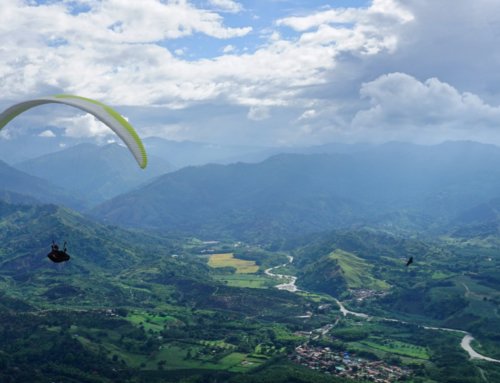Canopy porosity
In the past two articles we’ve focussed on line length and strength. But our gliders’ performance and safety also depends critically on the porosity of the fabric because increased porosity will reduce internal pressure. So how good does the porosity have to be, and what causes it to degrade?
Early paragliders were made out of material closely related to that used to make spinnaker sails, but over time the particular requirements of our wings, together with improvements in weaving and coatings, have resulted in very specialist textiles.
The weight of a fabric is an important determinant of its strength and elasticity. These key factors affect how long it will be before the coating that stops it being porous begins to break down. Weight is usually measured in grams per square metre. The other number you often see included in the fabric name is the weight of the yarn to weave the cloth. For example, 30DD means the manufacturer used yarn of dernier 30 – defined as the weight in grams of a 9,000m length of yarn!
Some older gliders we see in the workshop use heavier fabrics, such as the Airwave Sport of 2002, made with Gelvenor fabric weighing 49g per square metre. Newer gliders mostly use lighter fabrics of around 40g/sqm, predominantly made by Dominico of Korea or Porcher of France. Recently Porcher developed Skytex 32 (weighing 32g/sqm) using a 30DD yarn in one direction and 20DD in the other, recognising that canopy tension is much greater across the span than along the chord. Advance’s IOTA and Gin’s Sprint 3 both use this material. Lightweight glider designs (such as Ozone’s Enzo 2 and Zeno) often use Porcher’s Skytex 27, with a heavier material towards the leading edge.
Manufacturers understandably tend to offer caveats around the need to take more care with lightweight designs. But what about the standard designs: are lighter fabrics going to prove less durable? Ozone used a 40g cloth on the original Delta, and the porosity of the ones we’ve seen in the workshop has been good to ‘as new’ after 5 – 6 years.
Perhaps we also need to consider the other major factors that cause porosity to degrade: UV, damp ,heat and abrasion. Recent glider fabrics have improved their resistance to the first two significantly and their coatings adhere better, so a newer lightweight fabric can be expected to outperform an older, heavier fabric on these scores. So perhaps if we take care of our wings (see insert), newer models will last just as long.
Checking fabric porosity is the first test we do on a service, particularly important for a glider nearing the end of its serviceable life. The porosity meter [IMG_8442] measures how long it takes to draw 0.25 litres of air through a small (38.5 cm2) area of fabric using a weight hanging from rubber bellows. For a new glider this will take several minutes, but that time declines 10% to 30% a year, and sometimes as much as 50%. [Porosity changing over time] Anything less than 20 seconds we will examine very carefully.
Manufacturers’ guidance varies on exactly how porous a fabric can become before a glider becomes unairworthy, but typically it corresponds to readings around 10 to 15 seconds. Some manufacturers only require testing of the upper surface (NOVA, Advance and Skywalk for example) because the pressure differential is greater across that surface.
If your wing is getting on a bit, and the fabric is looking tired, it may be worth getting its porosity checked. And if the canopy feels a bit slacker than it used to, is tending to collapse a bit more or doesn’t feel as solid on bar, they may also be symptoms to consider.
Taking care of your canopy
None of this is rocket science, but may be worth just reminding ourselves.
- UV Don’t lay your glider out in the sun while waiting to take off. Rose it up and if possible, put it in shade.
- Heat Avoid leaving your wing in a hot car.
- Damp Even if your glider only got slightly damp, don’t leave it wrapped up that way until you next fly.
- Abrasion Avoid walking on your wing, and perfect those ground handling skills to minimise dragging it across the ground.
- Sand Empty out sand immediately because the particles can damage the fabric coating, particularly when packing away.
- Dirt A damp cloth is the best approach. Avoid getting your glider thoroughly wet and never use detergent or chemicals.
- Salt Like dirt – best avoided if possible. If your glider gets soaked in the sea, rinse in fresh water as soon as possible – don’t let salt crystals form in the fabric and lines.
If you want to chat anything through, we’re always happy to offer help and advice over the phone (01433 627195) or by email (info@aerofix.com).


